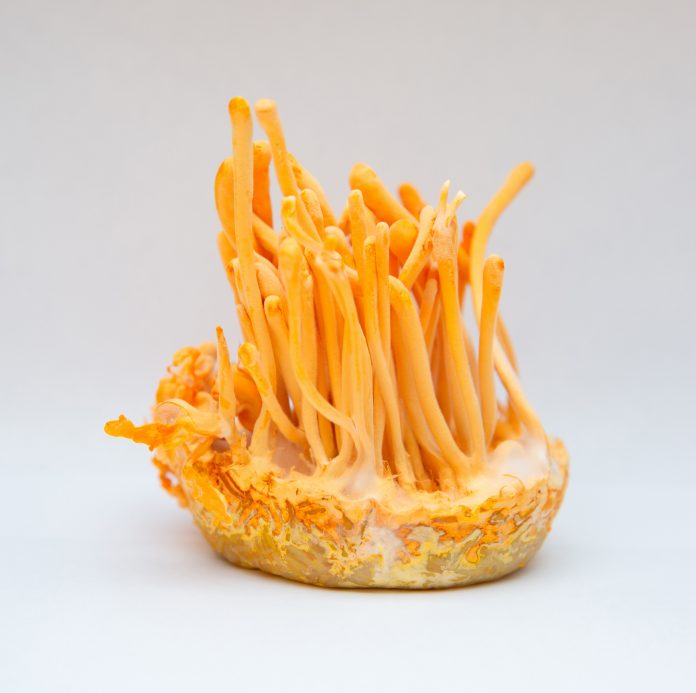
Researchers in Korea have discovered a way to increase production of cordycepin, a compound with anti-cancer potential, using edible insects as a growth medium for the mushrooms from which it can be extracted.
Cordyceptin is a nucleoside analog and major active constituent of the Cordyceps militaris mushroom. It has been reported to have anti-inflammatory, antioxidant, anti-aging, antibacterial, and anticancer activity but synthesizing it in a laboratory is difficult and the mushroom is rare in the wild.
“Recently cordycepin has shown potential for a variety of cancer types. For instance, cordycepin inhibited colon cancer cell proliferation by down-regulating MYC mRNA/protein expression and up-regulating miR-26a in both HCT116 and Caco-2 cells,” explained lead researcher Mi Kyeong Lee, from Chungbuk National University, in Cheongju, South Korea.
It has also been shown to reduce the chemotactic migration ability of liver cancer cells to stromal cell‑derived factor and inhibit the ERK/Slug signaling pathway through the activation of GSK3β which, in turn, upegulates Bax, leading to apoptosis of lung cancer cells.
In the laboratory, Cordyceps is typically grown on grains due to their convenience and availability, but insects are its natural host. These contain higher amounts of protein, which serves as a source of the carbon and nitrogen necessary for cordycepin synthesis.
However, Lee noted that cordycepin output is currently way below the level needed by researchers, and this has led to its market price climbing over 40-fold in the last 15 years, from around $12,000/kg in 2006 to more than $500,000/kg in 2019.
In order to try and overcome some of the difficulties with cordycepin production, Lee and team investigated whether edible insects could be used as a substrate for Cordyceps. They grew the mushroom on crickets (Gryllus bimaculatus, silkworm pupae (Bombyx mori), mealworms (Tenebrio molitor), grasshoppers (Caelifera sp.), white-spotted flower chafer larvae (Protaetia brevitarsis), and Japanese rhinoceros beetles (Allomyrina dichotoma).
The team found that Cordyceps grown on Japanese rhinoceros beetles had the highest cordycepin content, at 89.5 mg/g dry-weight, and this was 34 times higher than the amount produced by Cordyceps grown on silkworm pupae.
Further investigation showed that the fatty acid content—specifically oleic acid content—of the insects was key to cordycepin production and not protein content as expected. Indeed, Japanese rhinoceros beetles had an oleic acid content of 10.8%, which corresponded to 84% of the total fatty acids, whereas it was only 0.4% in silkworm pupae, corresponding to 12.5% of total fatty acids in this species.
Lee et al. also observed that transcriptional levels of cns1 and cns2, genes involved in cordycepin biosynthesis, were approximately 50 times higher in Cordyceps grown on Japanese rhinoceros beetles than on other insects tested. And when oleic acid was added to a low-performing insect food, transcriptional levels of cns1 and cns2 increased threefold and 1.8-fold, respectively, while cordycepin content increased by 51.4%.
Lee said that her team now plan “to secure cordycepin for further optimization of cultivation factors not only using insects as substrates as reported in this study but also other factors including a good strain of Cordyceps militaris, additives to the substrates, and cultivation conditions.”
She added that an advanced method for the purification of cordycepin is also required, and once this is achieved, it may be possible to produce cordycepin in large amounts.
“By providing cordycepin in large-scale amounts, it will be easier and cheaper for scientists to work more on this molecule to improve the efficacy of cordycepin in cancer by undergoing clinical trials. Thus, in near future, we might have an anticancer drug made from cordycepin at a low cost for the patients,” Lee remarked.
The study findings are published in Frontiers in Miccobiology.













